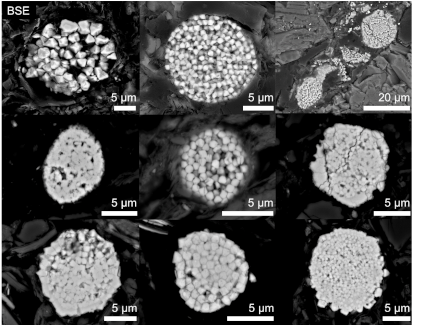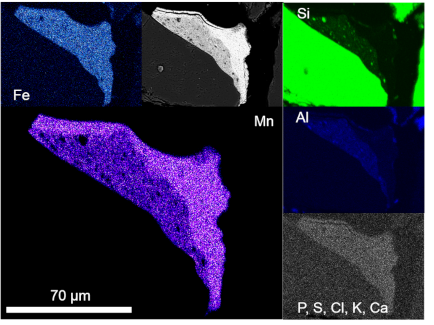Scientific background: Inorganic pollutants like As, Cr or Hg are frequently released into the environment through natural or anthropogenic processes. Some pollutants, like Se, are, depending on concentration and speciation, concurrently essential and toxic for plants and organisms. In our projects, we investigate processes and identify minerals that determine the (im-)mobilization and transport of elements in various settings. Our ambition is to track the fate of these elements in a holistic way, which means that we consider element transfer between and their ecological effect in different spheres, e.g. hydrosphere-pedosphere-biosphere. In this context, we use and improve highly sensitive analytical methods that work in all kind of sample matrices.
Our analytical strength and challenges
- Identification, characterization and quantification of minerals that occur in trace quantities in natural samples (e.g. soil, sediment, tailings), but still act as important sink or source for pollutants.
- Synthesis of pure and often redox-sensitive minerals (e.g. pyrite, green rust) under controlled laboratory conditions to understand their interaction with potential pollutants and identify important (im-)mobilization processes.
- Multi-element concentration measurement in individual mineral grains or plant parts.
- Determination of element speciation in liquid and solid samples without major changes through the analytical process to predict the pollutant mobility and toxicity.
- Non-destructive determination of pollutant concentration in solid samples using XRF in complicated matrices.
Analytical possibilities
Current research topics and projects
- Mineralogy of iron oxide/hydroxide phases along redox gradients in an arsenic contaminated aquifer in Van Phuc, Vietnam (AdvectAs) (GEPRIS-DFG)
-
Arsenic speciation and distribution in peat deposits of the Hetao Basin, China
-
Mercury distribution and speciation in a historic amalgamation site in Cedral S.L.P., Mexico (QUAKBES)
- Chromium reduction by green rust (MetalAID)
Selected publications
- Eiche, E., Nothstein, A.K., Göttlicher, J., Steininger, R., Dhillon, K.S., Neumann, T., 2019. The behaviour of irrigation induced Se in the groundwater-soil-plant system in Punjab, India. Environmental Science: Processes & Impacts, 2019, DOI: 10.1039/C9EM00009G.
- Thomas A.N., Eiche E., Göttlicher J., Steiniger R., Benning L.G., Freeman H.M., Dideriksen K., Neumann T. 2018. Products of Hexavalent Chromium Reduction by Green Rust Sodium Sulfate and Associated Reaction mechanisms. Soil Systems 2, 58. doi:10.3390/soilsystems2040058.
- Börsig, N., Scheinost, A.C., Shaw, S., Schild, D., Neumann, T. 2017. Uptake mechanisms of selenium oxyanions during the ferrihydrite-hematite recrystallization. Geochemica et Cosmocimica Acta 206, 236-253.
- Nothstein, A., Eiche, E., Riemann, M., Nick, P., Winkel, L., Göttlicher, J., Steininger, R., Brendel, R., von Brasch, M., Konrad, G., Neumann, T. 2016. Tracking Se Assimilation and Speciation through the Rice Plant – Nutrient Competition, toxicity and Distribution. PLoS ONE 11(4): e0152081; doi:10.1371/journal.pone.0152081.
- Tang, X.,Berner, Z.,Nalcaci, O.O., Norra, S. 2015. Selective separation and pre-concentration of arsenite from arsenic enriched natural waters with three different adsorbents. Separation Science and Technology 50, 2112-2123.
- Neidhardt, H., Berner, Z., Freikowski, D., Biswas, A., Majumder, S., Winter, J., Gallert, C., Chatterjee, D., Norra, S. 2014. Organic carbon induced mobilization of iron and manganese in a West Bengal aquifer and the muted response of groundwater arsenic concentrations. Chemical Geology 367, 51-62.



